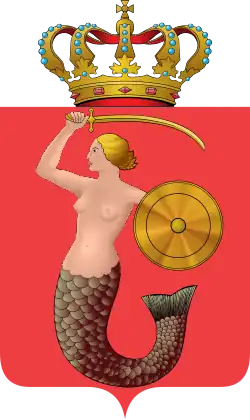Karolin, Warsaw
Karolin | |
|---|---|
 Połczyńska Street, near the intersection with Sochaczewska Street, in 2018. | |
| Coordinates: 52°12′56″N 20°53′11″E / 52.21556°N 20.88639°E | |
| Country | |
| Voivodeship | Masovian |
| City and county | Warsaw |
| District | Bemowo |
| City Information System area | Chrzanów |
| Incorporation into Warsaw | 14 May 1951 |
| Time zone | UTC+1 (CET) |
| • Summer (DST) | UTC+2 (CEST) |
| Area code | +48 22 |
Karolin is a neighbourhood and a warehouse district, in Warsaw, Poland, within the Bemowo district. It is located within the City Information System area of Chrzanów, in the area of Połczyńska Street, near the intersection with Dostawcza Street. Currently, the Karolin metro station, is being constructed in the neighbourhood, with plans to open in 2026.
History
By the 19th century, Karolin was a small farming community located near the Poznań Road (now Połczyńska Street). Since 1867, it has belonged to the municipality of Skorcze.[1] In 1921, it had 157 inhabitants, and in 1943, 277 inhabitants.[2][3]
On 14 May 1951, it was incorporated into Warsaw, becoming part of the Wola district.[4][5] On 29 December 1989, following an administrative reform in the city, it became part of the municipality of Warsaw-Wola, and on 25 March 1994, of the municipality of Warsaw-Bemowo, which, on 27 October 2002, was restructured into the city district of Bemowo.[5] In 1997, the neighbourhood became part of the City Information System of Chrzanów.[6]
In 2022, the construction Karolin metro station, began at the corner of Sochaczewska and Połczyńska Streets. It is part of the M2 line of the Warsaw Metro underground rapid transit system. The station is planed to be opened in 2026.[7][8]
Overview
Karolin is a warehouse district located alongside Połczyńska Street, near the intersection with Dostawcza Street.[9] Currently, within its boundaries is being built the Karolin metro station, as part of the M2 line of the Warsaw Metro underground rapid transit system, located at the intersection of Sochaczewska and Połczyńska Streets.[8]
References
- ^ Dziennik praw Królestwa Polskiego, Warsaw, 1964, p. 1272. (in Polish)
- ^ Skorowidz miejscowości Rzeczypospolitej Polskiej opracowany na podstawie wyników Pierwszego Powszechnego Spisu Ludności z dn. 30 września 1921 r. i innych źródeł urzędowych. T. 1 : m.st. Warszawa i Województwo warszawskie. Warsaw, 1921, p. 195. (in Polish)
- ^ Gemeinde- und Dorfverzeichnis für das Generalgouvernement Archived 2021-01-14 at the Wayback Machine. 1943.
- ^ "Rozporządzenie Rady Ministrów z dnia 5 maja 1951 r. w sprawie zmiany granic miasta stołecznego Warszawy". isap.sejm.gov.pl (in Polish).
- ^ a b Andrzej Gawryszewski: Ludność Warszawy w XX wieku. Warsaw: Instytut Geografii i Przestrzennego Zagospodarowania PAN, 2009, pp. 44–50. ISBN 978-83-61590-96-5. (in Polish)
- ^ "Dzielnica Bemowo". zdm.waw.pl (in Polish).
- ^ Jarosław Osowski (1 February 2023). "Budowa końcówki metra na ubogo, pytania do Trzaskowskiego bez odpowiedzi. Padł tylko jeden termin". warszawa.wyborcza.pl (in Polish).
- ^ a b Michał Mieszko Skorupka (1 February 2023). "Druga linia metra w Warszawie. Rafał Trzaskowski: Pasażerowie pojadą na Karolin w 2026 roku". warszawa.naszemiasto.pl (in Polish).
- ^ Studium uwarunkowań i kierunków zagospodarowania przestrzennego miasta stołecznego Warszawy ze zmianami Archived 2023-05-17 at the Wayback Machine. Warsaw: Warsaw City Council, 1 March 2018, pp. 10–14. (in Polish)
